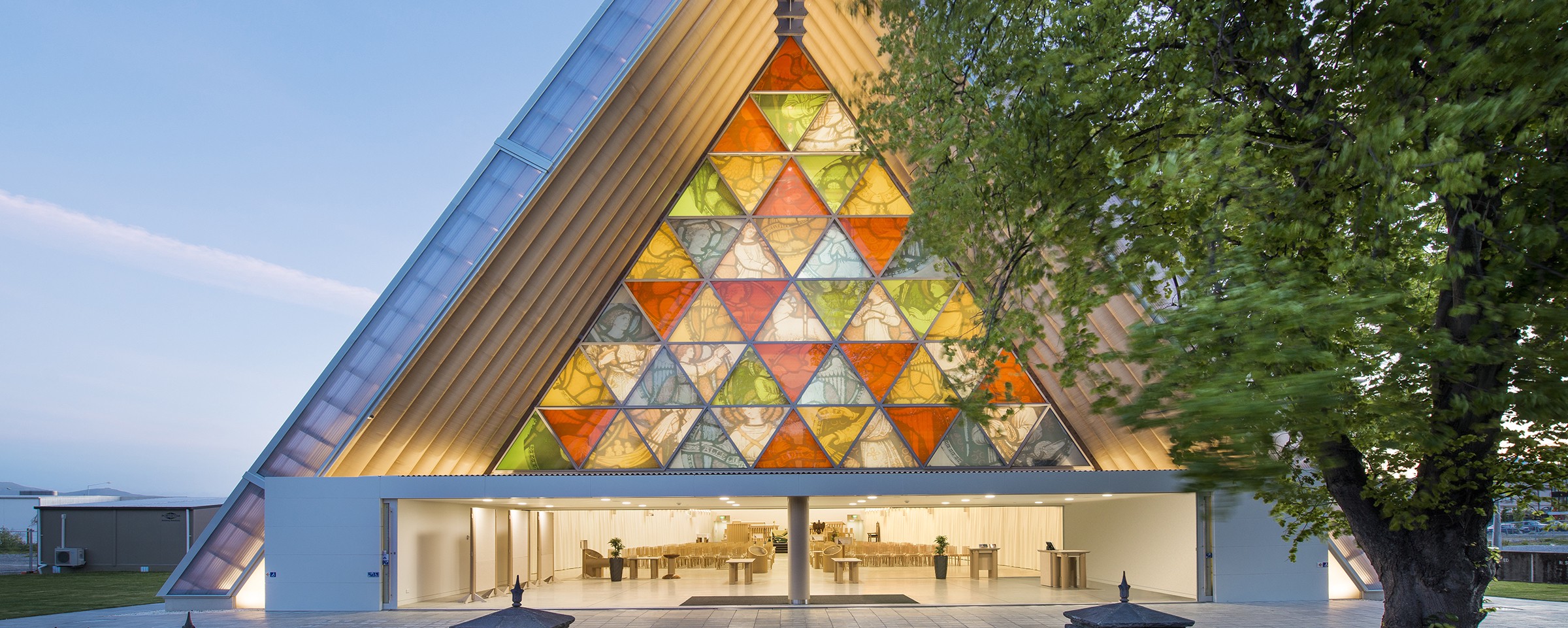

I remember how the cool air inside the Christchurch Cathedral once shielded me from the city and its noise. Set like a jewel in the heart of New Zealand’s third largest city, traffic flowed around its thick stone walls, the life outside muffled to a low murmur. We, the proud residents of the Canterbury region on the country’s South Island, boasted of our proximity to the mountains and the sea, of our compact inner city, of our beautiful heritage buildings. For the 370,000 people who live in Christchurch, there was no place else we wanted to be–and that’s still true today.
As a child, for me the 150-year-old cathedral was a compass point. My side of it was the neighborhood I knew like the scars on my knees; residential housing sprawling across the Canterbury Plains with farmyards close enough to smell them from my backyard on a hot, windy day. The other side of the cathedral seemed far away by comparison, a gray area of wetlands and the sea, as yet undiscovered by me.
Once I began the transition from child to teen, and then teen to adult, the cathedral became the central hub to self-discovery as I spent hours after school exploring the inner-city streets. Attending an inner-city high school meant that every day was an opportunity to walk down new streets, take new routes on the bus, and soak in the fumes of traffic and questionable liquids on the pavement. Then, disaster hit on February 22, 2011, at 12:51 p.m.
There was no warning sound before the earthquake rocked our land. There was nothing more than a jolt, 6.3 on the Richter scale, centered 3.1 miles [5 kilometers] beneath us–and our city was gone, sirens screaming, a sound we couldn’t yet make for the 185 people who died. With aftershocks rolling through every day after, many as large as 4 or 5 on the Richter scale, it was deemed too dangerous to return to school for a month.
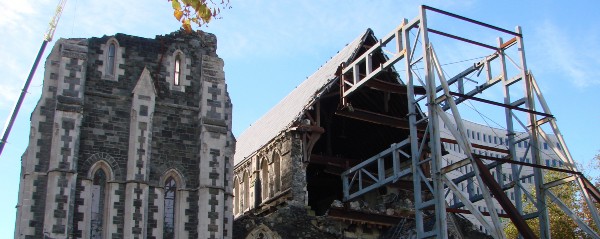
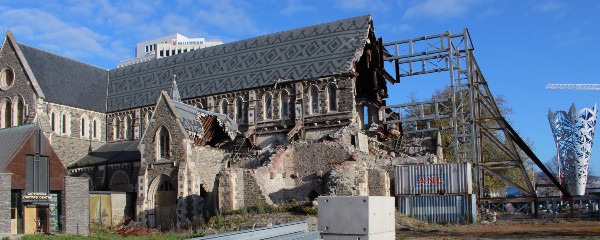
The red zone, a rectangular section of land between the city’s four main avenues (Bealey, Moorhouse, Deans, and Fitzgerald), remained closed for over two years after the earthquake. Within this cordon lay the remains of the cathedral’s front, its pieces scattered around the square. In many ways it became the most iconic image of the earthquake’s destruction, broadcast around the world. But it wasn’t until urban photographers broke in and showed us the piled-up pews, the dust covered floors, and the gaping hole ripped from ceiling to floor that we realized just how bad the damage was.
By the time the cordon was lifted, the streets were unrecognizable, and I became disorientated for the first time in my life. The strangest moment came as I was standing at the junction of Manchester and Lichfield Streets, staring down into the basement of the Majestic Theatre. The whole block, which had once contained the theatre, a multi-story parking garage, and a collection of bars and restaurants, had been demolished into nothing but gravel lots. In my mind, I could see the buildings’ shapes; in reality, there was nothing but gaps so big I could see cars driving down streets six blocks from where I stood. Christchurch had become the world’s largest parking lot.
No longer ignorant to the way the ground could move–left with a destroyed inner city and damaged homes–what made Christchurch worth staying and calling home for so many people?

Christina Stringer, a Canadian citizen who came to study at Teacher’s College at Canterbury University, found herself thrown into the midst of a natural disaster less than a month after arriving. Despite this introduction to the city, she chose to stay, and five years later she still lives in Christchurch teaching music. Moving to the other side of the world without having to deal with a natural disaster is a challenge, but Christina’s attitude toward making what she has in her hands work is an integral reason why Christchurch’s residents have repeatedly been called “resilient.”
What Stringer initially loved about the city was the ease with which she could escape the urban environment. She told me: “Coming from central Canada, with the ocean a mere 13-hour drive from my house and the mountains a good few days driving, it’s a novelty even five years later that I can drive 20 minutes and hit the beach, or an hour and be in the foothills of the mountains.”
However, it was in the rubble-filled city that she found something even more valuable. “Initially I came to Christchurch to study, but it is the people who keep me here,” Stringer said. “I have found the community I have wanted for a very long time, and I am not ready or willing to leave that any time soon.”
Despite the chaos in the first year after February’s earthquake, many community groups and organizations did their best to continue to meet regularly, often in each other’s houses. Most large buildings and meeting halls were still cordoned off, and with thousands of aftershocks rattling plates and people’s nerves, it felt safer to meet in places that were small and contained. People quickly signed up to join groups intent on bettering their community–like the student movement USCA Student Volunteer Army; or Gap Filler, which finds new community uses for abandoned plots of land; or RAD Bikes (short for “recycle a dunger,” Kiwi slang for an old bike), a free bike repair shed.
Within months, without prompting or funding from large governmental sectors, Christchurch residents were creating new communities and transforming dead space into places of refuge, calm, and beauty.
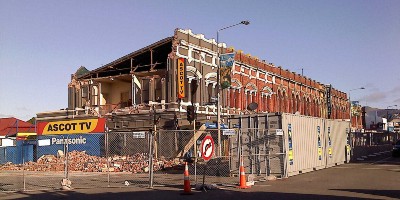
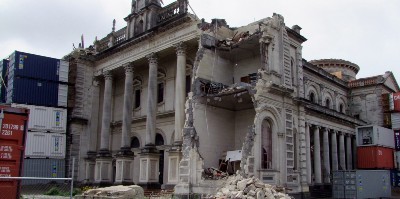
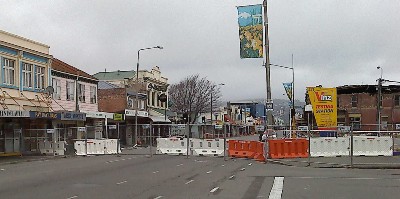
Raphael Nolden, another Christchurch resident who is here for the long haul, said: “The earthquake didn’t just breakdown physical walls but also psychological and societal ones. Christchurch now has an incredibly flat society. We live in a city where anyone can connect with anyone, and merit [or] effort is much more important than status and money.”
Nolden’s involvement with startup initiatives and experience in running a local business has given him a front-seat view of the reemerging city, a city where DIY creativity is getting much of the attention previously given to larger, established cultural and social institutions like the cathedral, the Arts Centre of Christchurch, and others based in historic Canterbury buildings. Each week a new pop-up gallery or co-working space opens, or meetups for artists are held. Nearly all of these events are hosted and created by people from within the community and are open to anyone wanting to join.
New ideas are constantly in development, and today Christchurch is buzzing with a community of people willing to give them a try. Like Nolden said, “If you need help, it is really just a matter of knowing what or who you need. [People] are what makes the city what it is and steers where it is going.” Both Nolden and Stringer share an excitement about the future of the city and their place in it. According to Stringer, “Though the earthquakes were a terrible tragedy, something beautiful has risen from its ashes. There is a sense of newness about this place.”
While the Christchurch Cathedral still stands in its place, it’s still in ruin–and still in limbo over whether it will be replaced or restored.
Meanwhile, the Cardboard Cathedral–designed by Japanese architect Shigeru Ban–has been embraced by a city that previously prided itself on its Gothic, English style. The substitute was built to last 50 years, and in a decade it will belong to the St. John’s Parish, whose land it sits on. Critics of the triangular, modern design–like local figure the Wizard of Christchurch–have called it kitsch, and attacked Anglican leaders for their decision to commission it.

The reality is that the building is a beautiful blend of sacred and practical, a characteristic key to the success of many of Christchurch’s transitional public spaces after the earthquake. We know that this Cardboard Cathedral–and other replacement buildings, like the Re:START Mall built out of shipping containers–are not permanent fixtures. Still, the quality of their design and innovation have never suffered for the rapidness of their construction, nor has our wholehearted enjoyment of them while they are here.
The indecision over the original cathedral has dragged on for five years, and Christchurch is not a city that can stand to be indecisive. As the traffic returns, flowing around its partially intact walls, and the surrounding businesses are demolished and rebuilt in time, the old heart of the city languishes in decay and pigeon droppings. The question of whether or not to preserve the historic buildings that remain is a crucial one–but not because buildings are important. Restoring the central compass point for many Christchurch residents could mean restoring and reengaging the community with our sense of history and our wider sense of belonging. Only within the context of our communities are cities ever worth living–and staying–in.


How We Get To Next was a magazine that explored the future of science, technology, and culture from 2014 to 2019. This article is part of our Metropolis section, on the way cities influence new ideas–and how new ideas change city life. Click the logo to read more.
